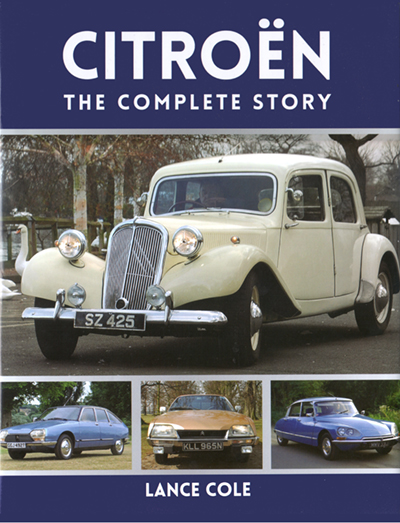|
The publisher’s description
says “In
this new view on the Citroen* story, Lance Cole
investigates not just
the details of the cars of Citroën, but the aeronautical
and cultural
origins that lay behind Citroën's form and function. The
book digs deep
into the ethos of Automobiles Citroën to create a
narrative on one of
the greatest car manufacturers in history. Using
interviews,
translations, archive documents and specially-commissioned
photographs,
the Citroën journey is cast in a fresh perspective.”
-
Explains in detail the influences upon Citroën
design: Voisin, Lefebve (sic), Bertoni, Boulanger, Mages
(sic), Opron
and recent Citroën designers such as Coco, Blakeslee and
Soubirou.
-
As well as all the men of the great period of 1920s
- 1970s expansion, cites less well-known names of
Citroën's French
engineering, design, and influence such as Cayla, Gerin,
Giret,
Harmand, Dargent and others, to give a full picture of
Citroën heritage
-
Provides in-depth analysis of all major Citroën models
with an engineering and design focus
-
Profiles key individuals and cars up to the present day
and Citroën's 'DS'-branded resurgence
-
Features many newly commissioned photographs, rare
archive
drawings and interviews with Citroën owners
-
Researched amongst leading Citroën experts and
restorers
* On their website, the name Citroën lacks the dieresis and
is spelled
Citroen and Lefebvre’s name is misspelt as is Magès and
while this
might seem ‘picky’ it is demonstrative of the slightly
slipshod
approach taken by the publisher which ruins what is an
otherwise
excellent book. Fortunately, the correct spelling is
used in the
book.
The finger of blame must also be pointed at Crowood for the
title. “The Complete Story” is a series of automotive
books. Unfortunately, it is not possible to cover the
‘complete
story’ of any automotive manufacturer in some three hundred
odd pages;
indeed there are books with more pages than this which are
dedicated to
a single model and these rarely manage to tell the entire
story.
So, a change of title would be a good idea.
I approached this book with a great deal of anticipation;
not least
because Lance and I had discussions while he was still
researching
it. I also greatly admire Lance as a writer. His
prose is
second-to-none and if anyone deserves the epithet of ‘the
new LJKS’
(Leonard Setright), it is Lance Cole. He has the knack
of making
quite complex issues easy to understand and, like LJKS, he
frequently
approaches his subject from a refreshingly new standpoint.
Where this book really excels is in its explanation of what
would
nowadays be called ‘Citroën’s corporate culture’ or ‘company
psychology’; of what made Citroën unique among motor
manufacturers in
an era when the ground rules for car design had not been
established. He explains how the company’s design team
was given
a free hand to investigate new and radical solutions rather
than merely
refine existing solutions; and to develop new technologies
when
existing ones were found to be lacking.
The principal models each have a chapter dedicated to them
and as
mentioned above, Lance brings a new perspective to his
descriptions of
them.
The book does, however, have a number of flaws.
Probably the most
serious is the poor proofing with lots of typos being left
uncorrected. There are a few minor errors and some
surprising
omissions (including a couple of pictures of the Belphégor
trucks but
no explanation of what these are). Citroën’s trucks
and buses are
not covered. Citroën’s operations in North America are
covered,
albeit somewhat superficially but the company is called
Citroën America
rather than Citroën Cars Corporation.
Some of the non-period pictures were clearly taken at
Citroën meetings
and sadly, some of these are poorly cropped. I would
rather have
seen more contemporary pictures.
I found the layout rather dated with text boxes breaking up
the flow of
the prose.
To sum up then, this book is a flawed diamond. Were it
not for
the proofing, it would merit 5 stars. The majority of the
shortcomings
would seem to be the fault of the publisher. However,
as an
exposition of what made Citroën unique, it is unparalleled
and
therefore comes strongly recommended.
|


